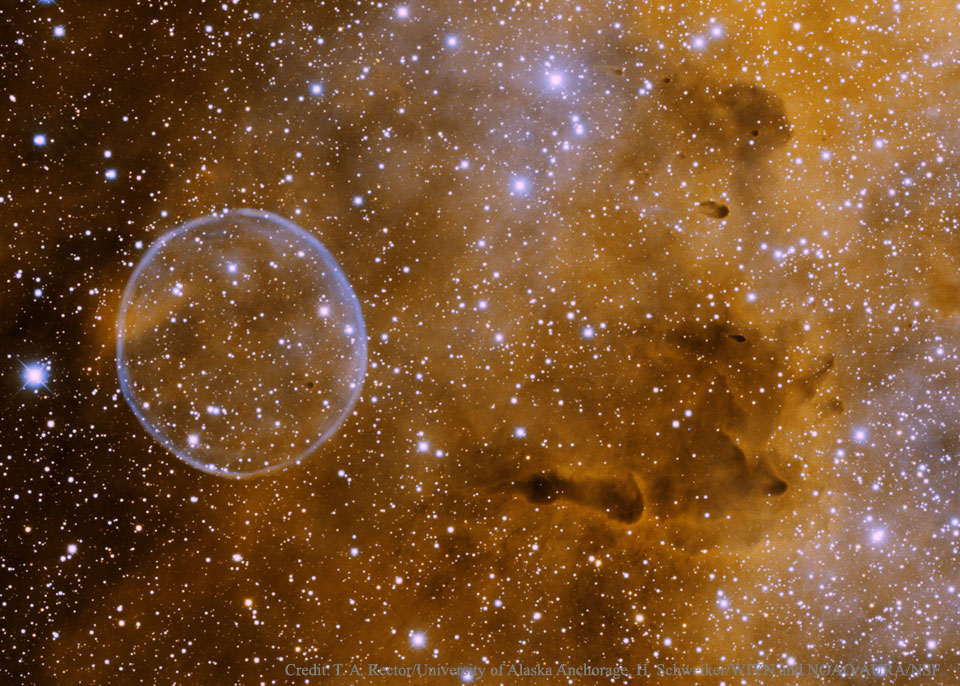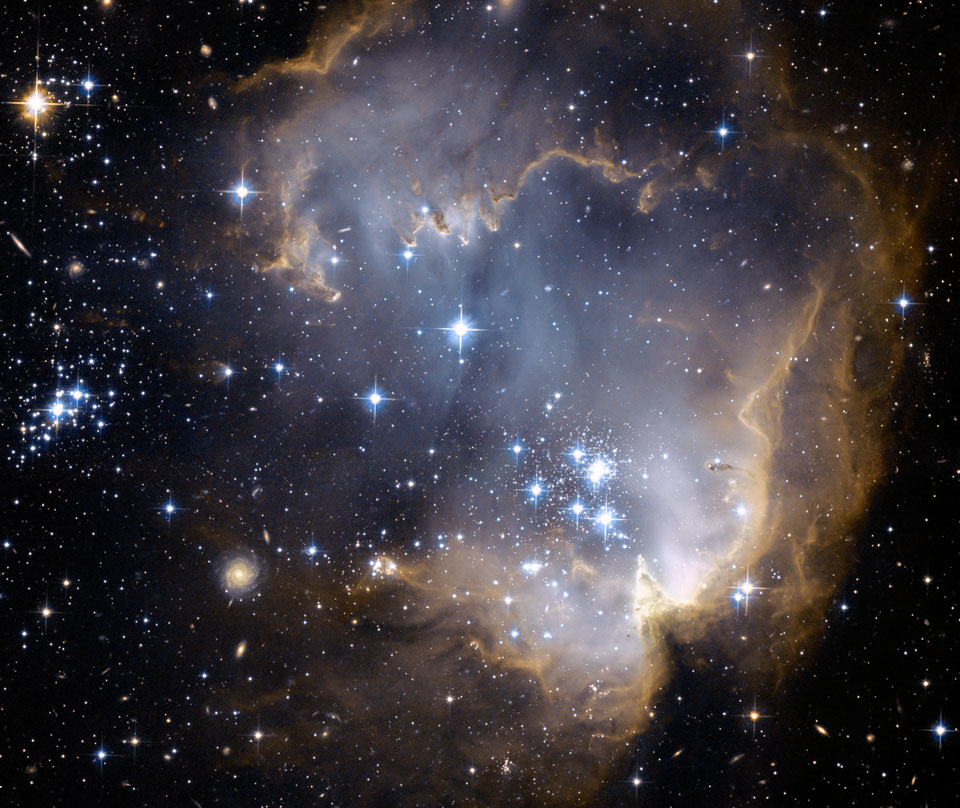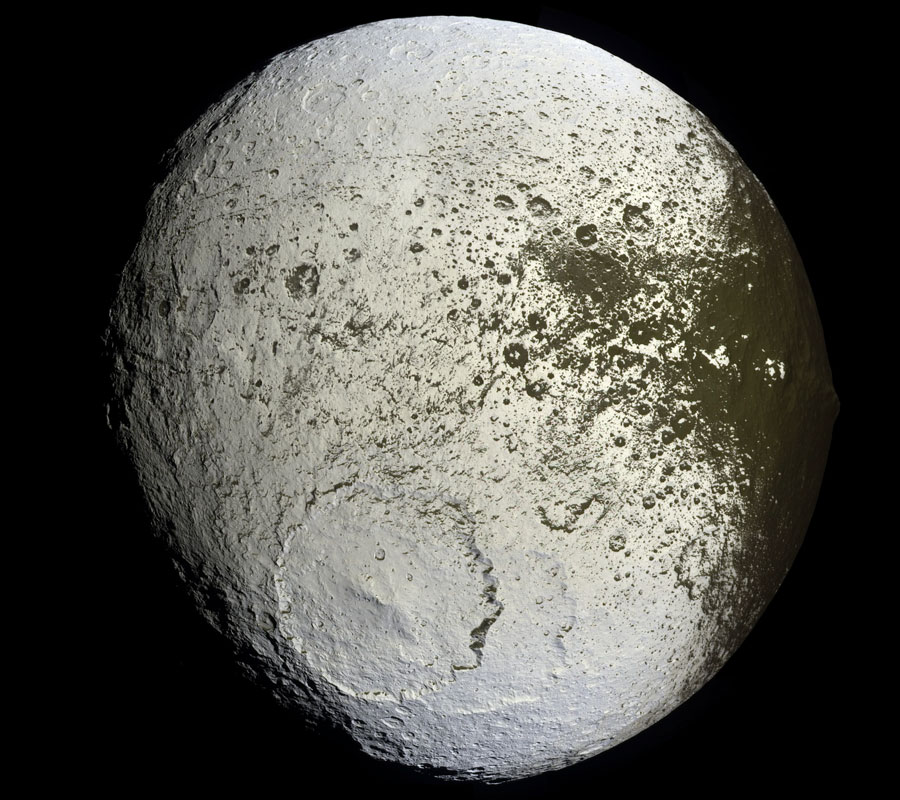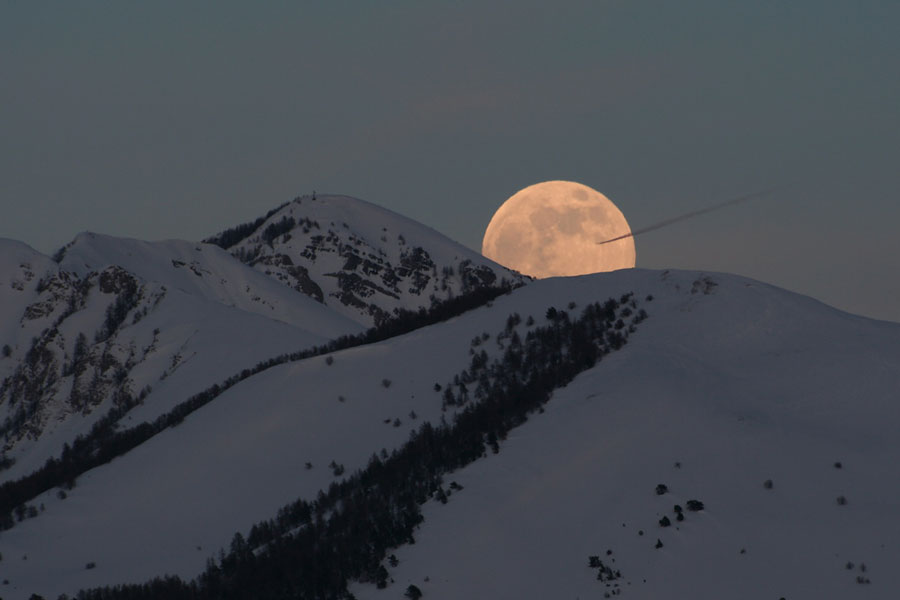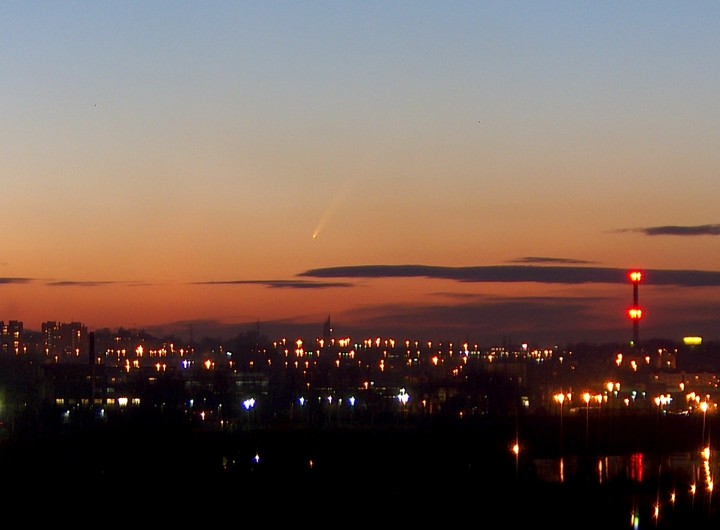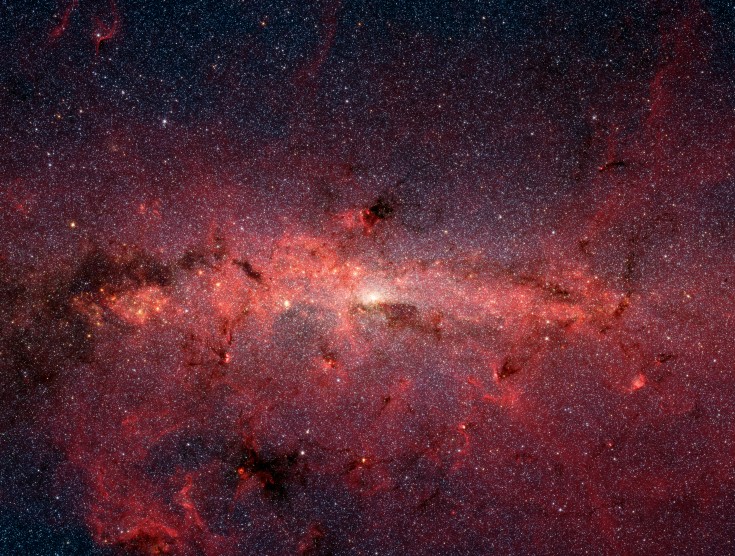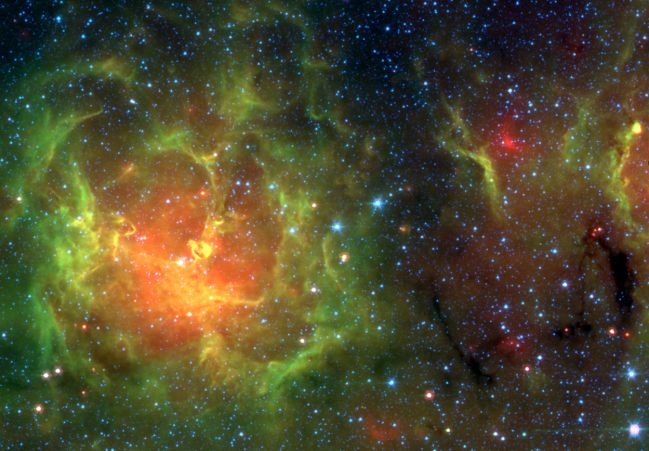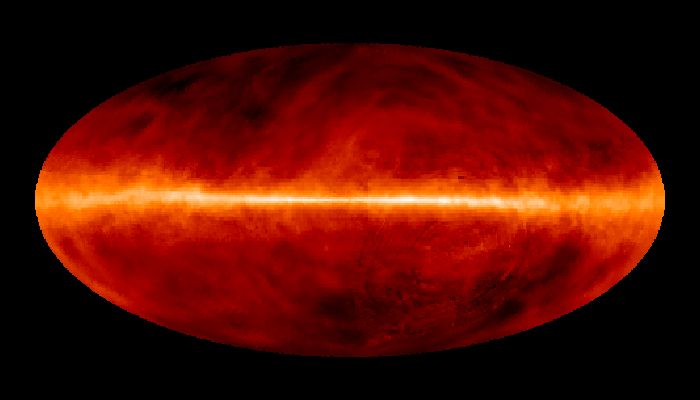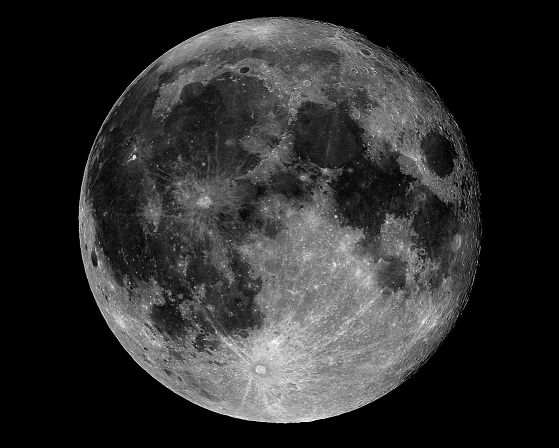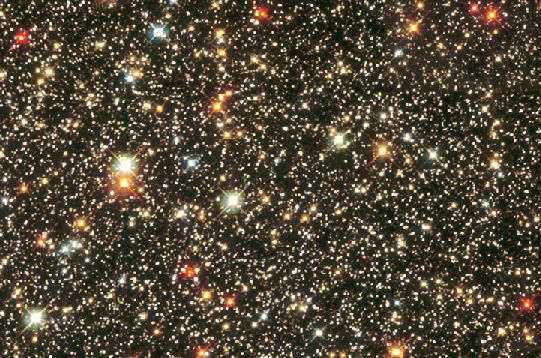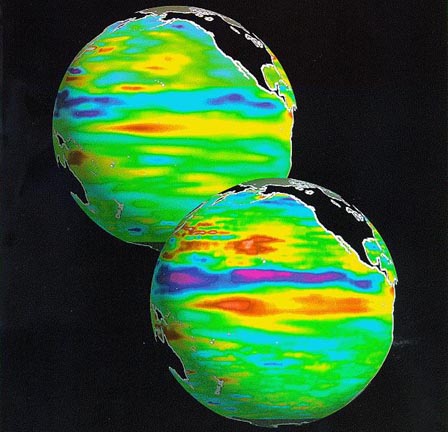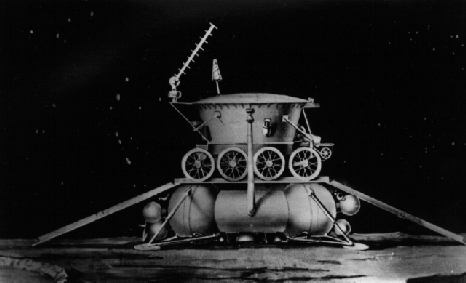| << Previous | Index | Next >> |
2015 Adrift in the rich star fields of the constellation Cygnus, this lovely, symmetric nebula was only recognized a few years ago and does not yet appear in some astronomical catalogs. In fact, amateur astronomer Dave Jurasevich identified it as a nebula on 2008 July 6 in his images of the complex Cygnus region that included the Crescent Nebula (NGC 6888). He subsequently notified the International Astronomical Union. Only eleven days later the same object was independently identified by Mel Helm at Sierra Remote Observatories, imaged by Keith Quattrocchi and Helm, and also submitted to the IAU as a potentially unknown nebula. The nebula, appearing on the left of the featured image, is now known as the Soap Bubble Nebula. What is the newly recognized nebula? Most probably it is a planetary nebula, a final phase in the life of a sun-like star.
2014 What would it be like to visit the Moon? The first major fictional cinematic film exploring this enduring transcultural fantasy was titled Le voyage dans la lune (A Trip to the Moon) and made in 1902, becoming one of the most popular movies of the early years of the twentieth century. The silent film starred the filmmaker Georges Melies himself and portrayed a club of astronomers voyaging to the Moon and back. Pictured above is a frame from the movie that has become an enduring icon for both film and space. Alluding to a bullseye trajectory, the Man in the Moon is caricatured as being struck by the human-built spaceship. The entire 14-minute film is now freely available. Visiting the Moon remained a very popular topic even 67 years later in 1969 when humans first made an actual voyage.
2013 Near the outskirts of the Small Magellanic Cloud, a satellite galaxy some 200 thousand light-years distant, lies 5 million year young star cluster NGC 602. Surrounded by natal gas and dust, NGC 602 is featured in this stunning Hubble image of the region. Fantastic ridges and swept back shapes strongly suggest that energetic radiation and shock waves from NGC 602's massive young stars have eroded the dusty material and triggered a progression of star formation moving away from the cluster's center. At the estimated distance of the Small Magellanic Cloud, the picture spans about 200 light-years, but a tantalizing assortment of background galaxies are also visible in the sharp Hubble view. The background galaxies are hundreds of millions of light-years or more beyond NGC 602.
2012 What has happened to Saturn's moon Iapetus? Vast sections of this strange world are dark as coal, while others are as bright as ice. The composition of the dark material is unknown, but infrared spectra indicate that it possibly contains some dark form of carbon. Iapetus also has an unusual equatorial ridge that makes it appear like a walnut. To help better understand this seemingly painted moon, NASA directed the robotic Cassini spacecraft orbiting Saturn to swoop within 2,000 kilometers in 2007. Pictured above, from about 75,000 kilometers out, Cassini's trajectory allowed unprecedented imaging of the hemisphere of Iapetus that is always trailing. A huge impact crater seen in the south spans a tremendous 450 kilometers and appears superposed on an older crater of similar size. The dark material is seen increasingly coating the easternmost part of Iapetus, darkening craters and highlands alike. Close inspection indicates that the dark coating typically faces the moon's equator and is less than a meter thick. A leading hypothesis is that the dark material is mostly dirt leftover when relatively warm but dirty ice sublimates. An initial coating of dark material may have been effectively painted on by the accretion of meteor-liberated debris from other moons. This and other images from Cassini's Iapetus flyby are being studied for even greater clues.
2011 Gorgeous spiral galaxy NGC 3521 is a mere 35 million light-years distant, toward the constellation Leo. Spanning some 50,000 light-years, its central region is shown in this dramatic image, constructed from data drawn from the Hubble Legacy Archive. The close-up view highlights this galaxy's characteristic multiple, patchy, irregular spiral arms laced with dust and clusters of young, blue stars. In contrast, many other spirals exhibit grand, sweeping arms. A relatively bright galaxy in planet Earth's sky, NGC 3521 is easily visible in small telescopes, but often overlooked by amateur imagers in favor of other Leo spiral galaxies, like M66 and M65.
2010 Bright clusters and nebulae abound in the ancient northern constellation of Auriga. The region includes the open star cluster M38, emission nebula IC 410 with Tadpoles, Auriga's own Flaming Star Nebula IC 405, and this interesting pair IC 417 (lower left) and NGC 1931. An imaginative eye toward the expansive IC 417 and diminutive NGC 1931 suggests a cosmic spider and fly. About 10,000 light-years distant, both represent young, open star clusters formed in interstellar clouds and still embedded in glowing hydrogen gas. For scale, the more compact NGC 1931 is about 10 light-years across.
2009 A larger moon will not be seen this year. This past weekend, the largest full Moon of 2009 could be seen from almost any clear location on planet Earth at night. The large angular extent of the full Moon was caused by the Moon being unusually close to Earth during its full phase. Because the Moon circles the Earth in an elliptical orbit, its angular size depends on how close the Moon is to closest approach (perigee) or farthest distance (apogee). Even so, the Moon's was only about 15 percent larger in area and brightness than a more typical full Moon. In this image, a dramatically positioned Moon is seen rising above the Alps from Breil-sur-Roya in the southeast of France. Taken with an ordinary digital camera but extraordinary timing, the image also captured a crossing jet plane. The last full Moon, in 2008 December, was the largest full moon of 2008.
2008 Ninety percent of the houses on Grenada were damaged by the destructive force of Hurricane Ivan. At its peak, Ivan was a Category 5 hurricane, the highest power category on the Saffir-Simpson Scale, and created sustained winds in excess of 200 kilometers per hour. Ivan was the largest hurricane to strike the US in 2004, and, so far, the 10th most powerful in recorded history. As it swirled in the Atlantic Ocean, the tremendous eye of Hurricane Ivan was photographed from above by the orbiting International Space Station. The name Ivan has now been retired from Atlantic Ocean use by the World Meteorological Organization.
2007 Bright Comet McNaught (C/2006 P1) graced the twilight this week, seen by many and often described with superlatives. Watching the skies over Krakow, Poland, Andrzej Sawow recorded this view on Wednesday - with an ordinary handheld digital camera. He notes that "... astronomy is really for everyone who loves to look at the night sky. And fortunately (sometimes) the sky generously rewards its observer". Now very close to the Sun, Comet McNaught (along with Mercury) is visible in realtime images from the SOHO spacecraft. Otherwise, skywatchers will find the comet hard to see this weekend. But southern hemisphere observers could be rewarded next week as Comet McNaught begins to climb higher in southern skies.
2006 The center of our Milky Way Galaxy is hidden from the prying eyes of optical telescopes by clouds of obscuring dust and gas. But in this stunning vista, the Spitzer Space Telescope's infrared cameras, penetrate much of the dust revealing the stars of the crowded galactic center region. A mosaic of many smaller snapshots, the detailed, false-color image shows older, cool stars in bluish hues. Reddish glowing dust clouds are associated with young, hot stars in stellar nurseries. The galactic center lies some 26,000 light-years away, toward the constellation Sagittarius. At that distance, this picture spans about 900 light-years.
2005 The Trifid Nebula, aka M20, is easy to find with a small telescope, a well known stop in the nebula rich constellation Sagittarius. But where visible light pictures show the nebula divided into three parts by dark, obscuring dust lanes, this penetrating infrared image reveals filaments of luminous gas and newborn stars. The spectacular false-color view is courtesy of the Spitzer Space Telescope. Astronomers have used the Spitzer infrared image data to count newborn and embryonic stars which otherwise can lie hidden in the natal dust and glowing clouds of this intriguing stellar nursery. As seen here, the Trifid is about 30 light-years across and lies only 5,500 light-years away.
2004 The Apollo 15 mission to Earth's Moon was dedicated to better understanding the surface of the moon by exploring mountains, valleys, maria, and highlands. Astronauts David Scott and James Irwin spent nearly three days on the Moon while Alfred Worden orbited above in the Command Module. The mission, which blasted off from Earth on 1971 July 26, was the first to deploy a Lunar Roving Vehicle. Pictured above in this digitally stitched mosaic panorama, David Scott examines a boulder in front of the summit of Mt. Hadley Delta. The shadow of James Irwin is visible to the right, while scrolling to the right will reveal a well-lit and diverse lunar terrain. The Apollo 15 mission returned about 76 kilograms of moon rocks for detailed study. Want to pan across the surface of Mars, too? Check out the color panoramic view from the Spirit landing site.
2003 The first hint of what will become of our Sun was discovered inadvertently in 1764. At that time, Charles Messier was compiling a list of "annoying" diffuse objects not to be confused with "interesting" comets. The 27th object on Messier's list, now known as M27 or the Dumbbell Nebula, is a planetary nebula, the type of nebula our Sun will produce when nuclear fusion stops in its core. M27 is one of the brightest planetary nebulae on the sky, and can be seen in the constellation Vulpecula with binoculars. It takes light about 1000 years to reach us from M27, shown above, digitally sharpened, in three isolated colors emitted by hydrogen and oxygen. Understanding the physics and significance of M27 was well beyond 18th century science. Even today, many things remain mysterious about bipolar planetary nebula like M27, including the physical mechanism that expels a low-mass star's gaseous outer-envelope, leaving an X-ray hot white dwarf.
2002 Sixteen hundred years ago, Hypatia became one of the world's leading scholars in mathematics and astronomy. Hypatia's legendary knowledge, modesty, and public speaking ability flourished during the era of the Great Library of Alexandria. Hypatia is credited with contributions to geometry and astrometry, and she is thought instrumental in the development of the sky-measuring astrolabe. "Reserve your right to think, for even to think wrongly is better than not to think at all," Hypatia is credited with saying. "To teach superstitions as truth is a most terrible thing."
2001 Interstellar space is filled with extremely tenuous clouds of gas which are mostly Hydrogen. The neutral Hydrogen atom (HI in astronomer's shorthand) consists of 1 proton and 1 electron. The proton and electron spin like tops but can have only two orientations; spin axes parallel or anti-parallel. It is a rare event for Hydrogen atoms in the interstellar medium to switch from the parallel to the anti-parallel configuration, but when they do they emit radio waves with a wavelength of 21 centimeters (about 8 inches) and a corresponding frequency of exactly 1420 MHz. Tuned to this frequency radio telescopes have mapped the neutral Hydrogen in the sky. The above image represents such an all-sky HI survey with the plane of our Milky Way Galaxy running horizontally through the center. In this false color image no stars are visible, just diffuse clouds of gas tens to hundreds of light years across which cluster near the plane. The gas clouds seem to form arching, looping structures, stirred up by stellar activity in the galactic disk.
2000 This dramatically sharp picture of the full moon was recorded on 22 December, 1999 by astroimager Rob Gendler. Big, beautiful, bright, and evocative, it was the last full moon of the Y1.9Ks, pleasing and inspiring even casual skygazers. December's moon was special for another reason, as the full phase occurred on the day of the winter solstice and within hours of lunar perigee. The first full moon of the year 2000 will bring a special treat as well, presenting denizens of planet Earth with a total lunar eclipse. On Thursday evening, January 20, the moon will encounter the dark edge of Earth's shadow at 10:01 PM Eastern Time with the total eclipse phase beginning at 11:05 PM and lasting for 77 minutes. This lunar eclipse will be visible from North and South America and Western Europe (total phase begins at 4:05 AM GMT January 21).
1999 Stars come in all different colors. The color of a star indicates its surface temperature, an important property used to assign each star a spectral type. Most stars in the above Sagittarius Star Cloud are orange or red and relatively faint, as our Sun would appear. The blue and greenish stars are hotter, many being relatively young and massive. The bright red stars are cool Red Giants, bloated stars once similar to our Sun that have entered a more advanced stage of evolution. Stars of the Sagittarius Cloud lie towards the center of our Galaxy - tantalizing cosmic jewels viewed through a rift in the dark, pervasive, interstellar dust. This famous stellar grouping houses some of the oldest stars known.
1998 This year's El Niño is the strongest ever recorded. The large amount of warm water in the Pacific Ocean near the equator is causing unusual weather all over planet Earth. The above false-color images of Earth show the relative levels of warm water between normal (upper left) and the comparatively mild El Niño of 1995 - 1996. Red indicates a high water level. Detailed measurements of this years El Niño indicate the warm water level is rising and falling in rhythmic fashion, possibly in response to changing wind patterns.
1997 Our Sun has spots! These spots appear dark in photographs like the one above, but in fact sunspots are quite bright - they are just dark compared to the rest of the Sun. Sunspots are about the size of the Earth and frequently occur in groups, as shown above. Sunspots occur when a concentrated portion of the Solar magnetic field pokes through the surface. This field slows energy from entering the sunspot region, causing sunspots to appear cooler, darker, and lower than the surrounding surface. Sunspots typically last about a month or two before dissipating. The number of sunspots is always changing, generally going from a maximum to a minimum about every 5 ½ years. In fact, the Sun just passed a minimum last year. The Sun and sunspots should never be looked at directly.
1996 On November 17, 1970 the Soviet Luna 17 spacecraft landed the first roving remote-controlled robot on the Moon. Known as Lunokhod 1, it weighed just under 2,000 pounds and was designed to operate for 90 days while guided by a 5-person team on planet Earth at the Deep Space Center near Moscow, USSR. Lunokhod 1 actually toured the lunar Mare Imbrium (Sea of Rains) for 11 months in one of the greatest successes of the Soviet lunar exploration program. The futuristic looking eight wheeler is pictured here in an artist's conception atop its landing module. Ramps extend from both sides of the spacecraft allowing the rover to choose an alternative route to the surface if one side is blocked by boulders.
| << Previous | Index | Next >> |
